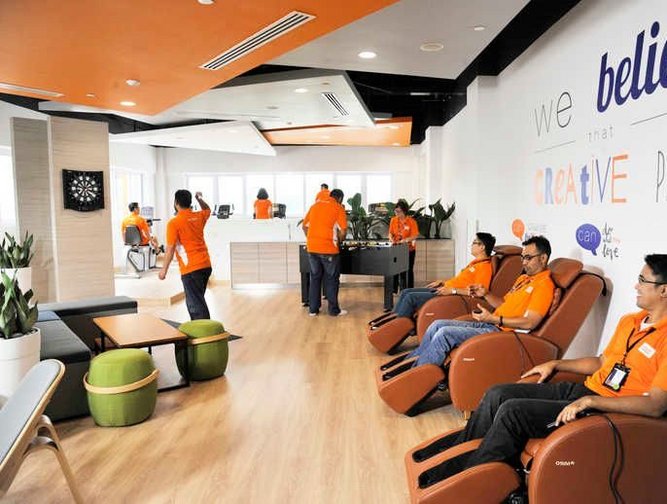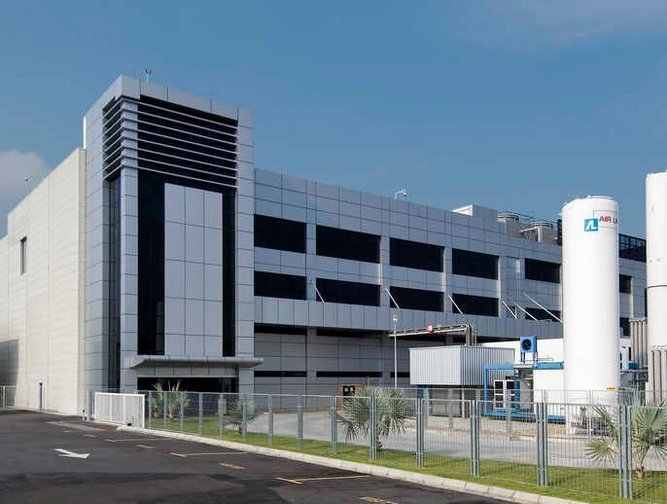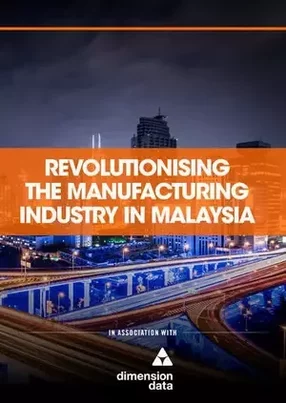OSRAM Opto Semiconductors: Unlocking potentials of light to improve people’s lives
With a history of over 110 years and based on more than 40 years of continuous innovation in opto semiconductors, OSRAM has set world leading standards in the fields of illumination, visualization, treatment and sensor technology. Its product portfolio covers mobility, increasing safety and security, creating connections, and enhancing health and well-being. Their mission is to improve people’s lives in almost all areas.
Commencing production in Malaysia in 1972 as Litronix before officially becoming OSRAM Opto Semiconductors (OSRAM OS) in 1999, the business has focused on transferring essential knowledge, building local talents and producing best-in-class products for the lighting market.
Joining OSRAM OS about 10 years ago, Director of Digital Manufacturing and Industrialization (DMI), Samivel Krishnamoorthy has been instrumental in its digitalisation journey. “In 2009, I joined OSRAM Penang - the first semiconductor wafer fabrication plant (Fab) of OSRAM OS outside of Germany. I was tasked to help address quality related issues due to manual processes performed by the operators. This task eventually expended to setting up dedicated teams working on Computer Integrated Manufacturing (CIM) and automation concepts throughout our Wafer Fab. In 2012 our Wafer fab achieved full CIM coverage. Now, we are extending this effort to our Assembly & Test facilities,” he says.
“Starting out in 2004 as a CIM Engineer in SilTerra Malaysia - a 200mm Wafer Fab, I got my grounding on CIM and Factory Integration, connecting tools to the host system and automating them. The CIM experience I gained, helped me realize that the factories of the future would progressively adopt CIM and Factory Integration.
“Coming from a semiconductor operational perspective and background, it helped me to identify and adapt to the differences of an integrated circuit (IC) Fab and Assembly & Test operations vis-a-vis compound semiconductor. The compound semiconductor industry, including companies like ours were not in the same league with our DRAM, NAND, Logic Fabs in terms of automation capabilities. Even for me, it took some transitioning to adapt to 100mm and later 150mm Fab environment as opposed to the familiar 200mm Fab experience I came from.”
Embracing change
From urbanization to digitalisation, infrastructure to security, Internet of Things (IoT), digital communication, smart cities and buildings along with human centric lighting and horticulture – OSRAM has its footprint in the thick of the lighting action. Mobility is also a significant area of focus, particularly in relation to autonomous driving.
“As these domains flourish and new ideas and innovations come to the fore, manufacturing operations need to be more flexible and scalable – meaning running multiple high mix low volume operations in parallel,” notes Samivel.
“We are becoming more customer centric and championing the ability to meet customers’ highest expectations. This means, organisations that were traditionally going for “high-volume” manufacturing models to meet their targets, may need to redefine their operational ideology to focus on “high value” manufacturing models. This inherently brings complexity that could redefine existing factory physics targets.
“At OSRAM OS, we needed to change the mindset of the people and convince them that there are more effective ways of doing things by delivering proof of concepts and moving people out of their comfort zones.”
Driving operational excellence
In his role as Global Requirement Management Director for OSRAM OS, Samivel is establishing the OS wide requirement management framework for the company’s Digital Manufacturing & Industrialisation initiatives. In addition to this, his CIM department currently works to support the five main business divisions within its Penang facility - comprising its Front-End Wafer Fab and four of its Assembly & Test functions, along with all associated R&D activities.
Samivel represents OSRAM in various external organisations such Crest (Collaborative Research in Engineering, Science and Technology) and TalentCorp to help develop Malaysia’s talent pool. In SEMI (Semiconductor Equipment and Materials International), he is a member of its Information & Control Technical Committee in reviewing and approving the Factory Integration related standards.
Digital investment
Whilst Samivel remains a key figure in the transformation of OSRAM OS’ manufacturing facilities in Penang and other locations, the business has looked to anchor its goals to the digitalisation levels achieved in the IC Fabs, and implement a global roadmap utilising de facto semiconductor norms.
“The main challenge we faced was in creating a paradigm shift in moving away from the old ways. Our branding tagline for our initiative – ‘LESS is MORE’ - serves as a catalyst to emphasise on the need to remove non-value-added processes either before or while automating/digitising our manufacturing lines. Some processes in this category involve operator decision making, human intervention in running equipment and transactional/logistical complexities,” he explains.
“Secondly, it was imperative to keep our intent focused proceduralising the value-added processes by focusing on a number of key things. These are monitorability, repeatability, controllability, flexibility – essentially keeping things simple.”
Moving away from introducing multiple systems to close the digitalisation gap, OSRAM OS has taken the more complex route of platforming its digitalisation tools. This is to scale on connectivity and create the necessary gravity by establishing a consistent optimised data flow throughout its Fabs. By assessing its own capabilities which align with semiconductor best practices, the business has harvested low hanging fruits by ticking off topics which are easily addressed before looking at further complex areas.
“We needed sound solution providers to realise our vision. Partners like Vistrian, ATOS, Dimension Data, our equipment suppliers, and a long list of others are the cogs in our digitalisation wheel in Penang. Once the baseline was established, we focused on completing system to system integration which was easiest to realise as those systems were under our direct control. Once the system to system integration was done, we coupled the system to equipment in our shop floor which was/and still is the more challenging part,” he continues.
“Our equipment suppliers were not known to support the compound semiconductor industry with the same integration capabilities offered to the semiconductor peers (in this case SEMI standards such as SECS/GEM and E142). It took a lot of discussions, negotiations and re-negotiations – and in some cases even haggling – to get them to agree and deliver such integration possibilities. Once achieved, we moved to making the requirements mandatory in our equipment procurement strategies. This cycle was also to repeat for our Assembly & Test implementations when we started later in 2014 and is still an ongoing practice we adhere to.”
Using the same platform for its Assembly & Test operations to capitalise on the possibility of operator mobility, the plan was initially met with skepticism. “Achieving this for an IC Assembly & Test operation is relatively easier as opposed to a compound semiconductor,” observes Samivel. “It took multiple tries within our teams along with top down targets and bringing in new blood into the organisation. Having the demand from customers to bring Front End capabilities into our Back End also helped give the necessary impetus for this initiative. We are currently deploying the same concepts and implementations in two of our sites in Wuxi, China and Kulim, Malaysia.”
Filtering into its transformation, OSRAM lives from employees contributing to the company's success with enthusiasm. Working in OSRAM means experiencing a trust-based atmosphere alongside open and respectful interaction. Investing in both technical competency related training and emotional quotient development, the business has established the OSRAM Skills and Development Center (OSDC), a dedicated building to support training activities all year long. Since its inception, it has become the central physical entity that focuses on OSRAM’s formation and propagation of career, operational, technical, academic and leadership development, along with digitalisation tool trainings and new employee orientation/integration programs.
“Our Managing Director - Dr. Roland Mueller is a strong advocate and believer in investing in people development. Under the auspices of OSDC – we aim to achieve our missions of:
- providing equal development opportunities for all employees, in both personal and professional aspects.
- to develop the full potential of employees through both technical and management programs.
- to provide structured programs and infrastructure that will produce competent and highly skilled employees.
- to encourage a culture of daring where failure and learning are part of the process.”
See also:
- AXA Life Japan: Technological innovation in Japan’s insurance industry
- Deloitte: enabling supply chain transformation
- How SCT Group leverages technology and a commitment to service to provide logistics solutions
Innovating for the future
As we keep innovating and improving our products and applications it will become increasingly essential for OSRAM to acquire the right products for each market, which can be further analyzed through the adoption of advanced data analytics.
“The products need to have staying power – needs to be of good quality – and a good data landscape with the right verifications and validations in place will help achieve that,” says Samivel.
In the adoption phase of big data at OSRAM, a number of consultancy firms have been brought in to further explore its potential. Additionally, it has sought to deploy a number of cloud-based solutions to support its productivity tools in relation to its IT systems.
“We have robotics running our major manufacturing processes, but we are also exploring possibilities of inter process logistical handling via the use of robotics – i.e. automated transport systems and also manual process automation with COBOTS. However, we are still in the evaluation stage and are hoping to kick-start some of these initiatives soon once we have the right teams established to champion this,” he adds.
“We are also currently deploying Customer Relationship Management (CRM) solutions from Salesforce to help with our forecasting topics and our customer relationship management. This is another digitalisation topic that we are excited about and that could also help us respond speedily to market demands,” he adds.
Housing a unique mission statement, to unlock the potential of light to improve people's lives, OSRAM’s diverse portfolio will continue to deliver significant financial gains.
“As we constantly raise the benchmark, our standards need to raise along with it,” says Samivel.
“Our customer feedback has been tremendously positive across all digitalisation initiatives. Our hiring strategies are going after the best in class talent pool who could work with these operational demands in a continuous improvement frame of mind. Our targets are continuously enhanced with newer strategies to be the market leader in our domain.”
“Samivel reminds organisations embarking on any digitalisation initiatives from throwing caution to the wind – as digital solutions alone will not solve all inherent organisational flaws. If there are inherent lack of manufacturing competencies, even the best in class solutions will fail to deliver the promised results. No amount of automation or artificial intelligence could compensate for the lack of operational understanding - and the investments might not yield the expected results. Therefore, any such endeavors should start by investing in equipping the people who run those processes the necessary core competencies” he ended.



- Comau's Automation Solutions for Outside of ManufacturingAI & Automation
- How Intelligent Automation is Reshaping ManufacturingSmart Manufacturing
- Optimising back-office operations with AI in manufacturingAI & Automation
- Panasonic Connect’s Autonomous Manufacturing SolutionsAI & Automation

